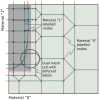Automatically generated, anatomically accurate meshes for cardiac electrophysiology problems
- PMID: 19203877
- PMCID: PMC2819345
- DOI: 10.1109/TBME.2009.2014243
Automatically generated, anatomically accurate meshes for cardiac electrophysiology problems
Abstract
Significant advancements in imaging technology and the dramatic increase in computer power over the last few years broke the ground for the construction of anatomically realistic models of the heart at an unprecedented level of detail. To effectively make use of high-resolution imaging datasets for modeling purposes, the imaged objects have to be discretized. This procedure is trivial for structured grids. However, to develop generally applicable heart models, unstructured grids are much preferable. In this study, a novel image-based unstructured mesh generation technique is proposed. It uses the dual mesh of an octree applied directly to segmented 3-D image stacks. The method produces conformal, boundary-fitted, and hexahedra-dominant meshes. The algorithm operates fully automatically with no requirements for interactivity and generates accurate volume-preserving representations of arbitrarily complex geometries with smooth surfaces. The method is very well suited for cardiac electrophysiological simulations. In the myocardium, the algorithm minimizes variations in element size, whereas in the surrounding medium, the element size is grown larger with the distance to the myocardial surfaces to reduce the computational burden. The numerical feasibility of the approach is demonstrated by discretizing and solving the monodomain and bidomain equations on the generated grids for two preparations of high experimental relevance, a left ventricular wedge preparation, and a papillary muscle.
Figures







Similar articles
-
An inner-outer subcycling algorithm for parallel cardiac electrophysiology simulations.Int J Numer Method Biomed Eng. 2023 Mar;39(3):e3677. doi: 10.1002/cnm.3677. Epub 2023 Jan 9. Int J Numer Method Biomed Eng. 2023. PMID: 36573938
-
Fast interactive simulations of cardiac electrical activity in anatomically accurate heart structures by compressing sparse uniform cartesian grids.Comput Methods Programs Biomed. 2024 Dec;257:108456. doi: 10.1016/j.cmpb.2024.108456. Epub 2024 Oct 24. Comput Methods Programs Biomed. 2024. PMID: 39476551
-
Simulating Cardiac Electrophysiology Using Unstructured All-Hexahedra Spectral Elements.Biomed Res Int. 2015;2015:473279. doi: 10.1155/2015/473279. Epub 2015 Oct 25. Biomed Res Int. 2015. PMID: 26583112 Free PMC article.
-
Image-based models of cardiac structure in health and disease.Wiley Interdiscip Rev Syst Biol Med. 2010 Jul-Aug;2(4):489-506. doi: 10.1002/wsbm.76. Wiley Interdiscip Rev Syst Biol Med. 2010. PMID: 20582162 Free PMC article. Review.
-
Generating anatomical models of the heart and the aorta from medical images for personalized physiological simulations.Med Biol Eng Comput. 2013 Nov;51(11):1209-19. doi: 10.1007/s11517-012-1027-0. Epub 2013 Jan 30. Med Biol Eng Comput. 2013. PMID: 23359255 Review.
Cited by
-
Arrhythmia risk stratification of patients after myocardial infarction using personalized heart models.Nat Commun. 2016 May 10;7:11437. doi: 10.1038/ncomms11437. Nat Commun. 2016. PMID: 27164184 Free PMC article.
-
Susceptibility to arrhythmia in the infarcted heart depends on myofibroblast density.Biophys J. 2011 Sep 21;101(6):1307-15. doi: 10.1016/j.bpj.2011.08.009. Epub 2011 Sep 20. Biophys J. 2011. PMID: 21943411 Free PMC article.
-
A computational study on the influence of antegrade accessory pathway location on the 12-lead electrocardiogram in Wolff-Parkinson-White syndrome.Europace. 2025 Feb 5;27(2):euae223. doi: 10.1093/europace/euae223. Europace. 2025. PMID: 39259657 Free PMC article.
-
Development of an anatomically detailed MRI-derived rabbit ventricular model and assessment of its impact on simulations of electrophysiological function.Am J Physiol Heart Circ Physiol. 2010 Feb;298(2):H699-718. doi: 10.1152/ajpheart.00606.2009. Epub 2009 Nov 20. Am J Physiol Heart Circ Physiol. 2010. PMID: 19933417 Free PMC article.
-
Whole-heart modeling: applications to cardiac electrophysiology and electromechanics.Circ Res. 2011 Jan 7;108(1):113-28. doi: 10.1161/CIRCRESAHA.110.223610. Circ Res. 2011. PMID: 21212393 Free PMC article. Review.
References
-
- Cabrera JA, Ho SY, Climent V, Sanchez-Quintana D. The architecture of the left lateral atrial wall: A particular anatomic region with implications for ablation of atrial fibrillation. Eur Heart J. 2008;29(3):356–362. - PubMed
-
- Sakamoto S, Nitta T, Ishii Y, Miyagi Y, Ohmori H, Shimizu K. Interatrial electrical connections: The precise location and preferential conduction. J Cardiovasc Electrophysiol. 2005;16(10):1077–1086. - PubMed
-
- Kim YH, Xie F, Yashima M, Wu TJ, Valderrabano M, Lee MH, Ohara T, Voroshilovsky O, Doshi RN, Fishbein MC, Qu Z, Garfinkel A, Weiss JN, Karagueuzian HS, Chen PS. Role of papillary muscle in the generation and maintenance of reentry during ventricular tachycardia and fibrillation in isolated swine right ventricle. Circulation. 1999;100(13):1450–1459. - PubMed
-
- Cabo C, Pertsov AM, Davidenko JM, Jalife J. Electrical turbulence as a result of the critical curvature for propagation in cardiac tissue. Chaos. 1998;8(1):116–126. - PubMed
Publication types
MeSH terms
Grants and funding
LinkOut - more resources
Full Text Sources
Other Literature Sources

